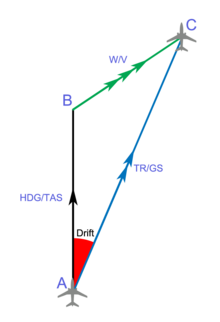
Back وجهة (ملاحة) Arabic Напрамкавы вугал Byelorussian Истински пеленг Bulgarian Cap (navigation) French Rumo (náutica) Portuguese Путевой угол Russian Yul poçmağı Tatar Шляховий кут Ukrainian

In navigation, the heading of a vessel or aircraft is the compass direction in which the craft's bow or nose is pointed. Note that the heading may not necessarily be the direction that the vehicle actually travels, which is known as its course or track. Any difference between the heading and course is due to the motion of the underlying medium, the air or water, or other effects like skidding or slipping. The difference is known as the drift, and can be determined by the wind triangle. At least seven ways to measure the heading of a vehicle have been described.[1]